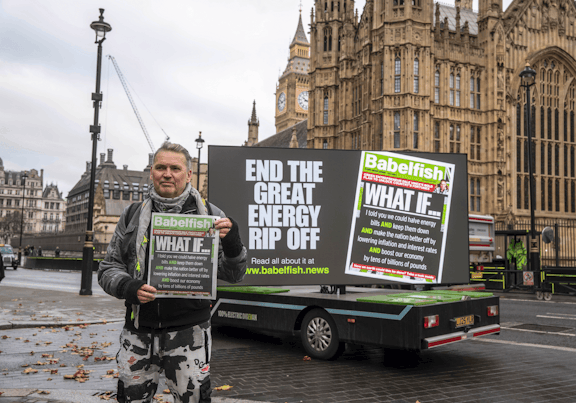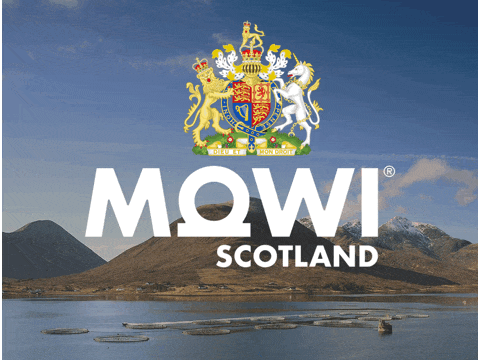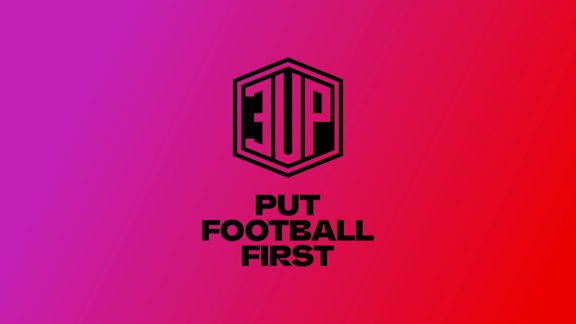
Campaign
Babelfish - a media platform for now
November 28, 2025
Despite what supermarket labels might suggest, wild Atlantic salmon and farmed salmon are two entirely different fish - from their diet and environment to their very colour. Yet, while wild salmon numbers are in freefall, farmed salmon production has exploded in the last 25 years - at a rate that’s completely unsustainable.
The UK’s wild Atlantic salmon population is now on the endangered IUCN Red List, and global Atlantic salmon numbers are nearing the same fate. But instead of protecting what’s left, we’ve ramped up industrial fish farming. In just 20 years, global salmon production has doubled - from 1.89 million metric tonnes in 2000 to 3.8 million in 2020. And virtually all of that growth has come from farmed salmon.
This isn’t just a crisis for wild fish - salmon farming is a disaster for the environment, and the animals trapped in this brutal industry.
Wild Atlantic salmon live how nature intended. They hatch in freshwater streams, develop for years, then migrate out to sea - where they spend most of their lives roaming freely. When it’s time to breed, they return to the very river they were born in, travelling upstream to lay eggs before dying shortly after.
Farmed salmon, on the other hand, live and die in a floating prison.
Born in captivity – Farmed salmon start life in indoor hatcheries before being moved to freshwater lochs or land-based tanks.
Crammed into sea cages – When they’re big enough, they’re transferred to cramped, filthy sea pens, where they spend the next 18 months growing to their ‘market size’ of 4–6kg.
Pumped full of chemicals – To keep them alive in these squalid conditions, they’re dosed with formaldehyde, Deltamethrin, and Azamethiphos, among other toxic chemicals.
Infested with sea lice – The sea lice crisis in salmon farms is so severe that entire wild populations are being wiped out when infested farmed fish escape.
Despite the industry’s chemical warfare, disease and infections run riot. Packed in at densities of 20kg per cubic metre, the salmon suffer from open sores, fungus-ridden skin, and organ failure.
International media - and our own Green Britain Foundation - have exposed these horrors. But the industry carries on, because demand keeps growing.
If being farmed wasn’t barbaric enough, the killing process is just as horrific.
Once salmon reach market weight, they’re either slaughtered on-site or transported to external plants, where they face one of several "humane" or inhumane killing methods:
Electrical or percussive stunning – The supposed humane option, though undercover investigations have shown fish regaining consciousness before they’re bled out.
Carbon dioxide gassing – The more sinister method. Fish are submerged in tanks of high-concentration CO₂ for 2–4 minutes. This causes:
Extreme distress
Violent head shaking
Erratic tail thrashing
A slow, suffocating death before they’re bled out.
Hidden footage has revealed salmon having their gills ripped out while still fully conscious. And where’s the oversight? Nowhere. Even the government admits there are zero routine checks on fish welfare at slaughter. No department wants to take responsibility.
Wild salmon get their deep pink colour naturally - from a shrimp-rich diet that’s also packed with protein and essential nutrients. Farmed salmon? They’d be a pale, unappetising grey if left to their natural diet.
So the industry fakes it.
Farmed salmon are fed fishmeal, fish oil, and plant-based feed, including corn and soy - crops that demand vast amounts of land and water.
To colour their flesh, they’re given synthetic astaxanthin, often derived from petrochemicals.
Without these additives, farmed salmon would be nutrient-deficient. They are completely reliant on artificial supplementation.
This raises two massive problems:
Feeding wild fish to farmed fish is an ecological disaster. The salmon farming industry is effectively turning fish into fish food, further depleting marine life.
Using crops like soy to feed farmed fish is driving deforestation. A study in New Scientist highlighted that when plant-based food is fed to livestock (or fish), it demands even more land and water - accelerating habitat destruction.
We’re wrecking wild fish stocks and razing forests, all to farm a species that should be left in the wild.
Fish farming is sold as a sustainable alternative to wild fishing, but that’s a lie. It’s just another industrialised animal farming system, riddled with all the same failings:
Vast resource consumption – From fishmeal to soy, farmed salmon are food and water guzzlers.
Chemical pollution – The toxic pesticides, antibiotics, and waste from sea cages contaminate surrounding waters, threatening wild fish.
Mass mortality rates – Scottish salmon farms recorded over 16 million deaths in 2022 alone - fish that suffered and died without even making it to a plate.
The simple truth is: farmed salmon isn’t food - it’s an environmental disaster dressed up as dinner.
The government is complicit. It continues to back fish farming despite overwhelming evidence that it’s unsustainable, unethical, and environmentally catastrophic.
Exposing the brutal truth of farmed salmon - their short, tortured lives, and agonising deaths - is essential. But exposing it isn’t enough.
We need government intervention to phase out this industry for good. We need action - before it’s too late.
Farmed salmon isn’t the answer. It never was.
Campaign
November 28, 2025
Government
November 23, 2025
Campaign
November 17, 2025
Football
November 13, 2025


